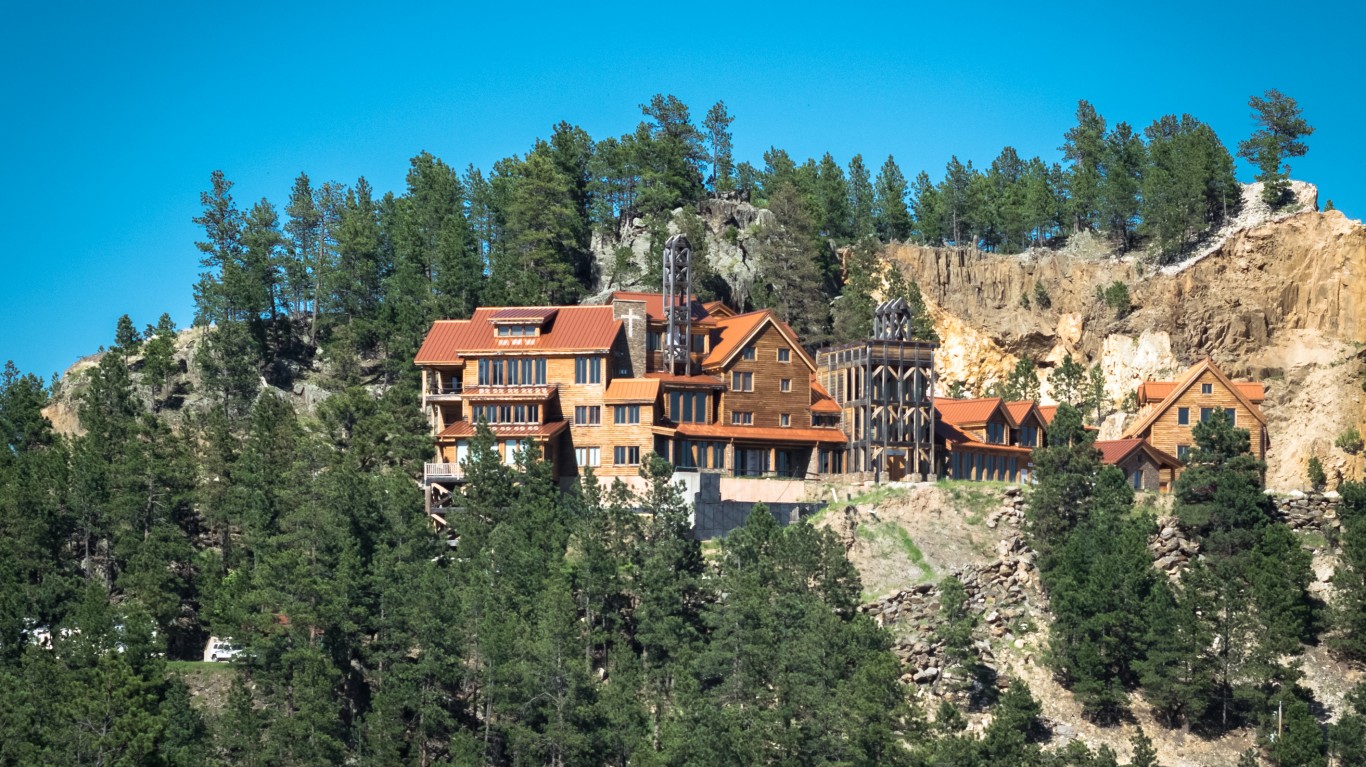
Alzheimer’s disease is a degenerative brain disorder that causes memory loss and impairs speech, behavior, and cognitive functions. The most common risk factor for the disease is age. The vast majority of Americans with Alzheimer’s disease are at least 65 years old.
The Alzheimer’s Association estimates that 5.8 million Americans 65 and older are living with the disease, as of 2020. As more and more of the baby boomer generation reaches that age, the number of Americans with the disease will increase to a projected 7.1 million people by 2025, an increase of nearly 22%. Yet this growth will not be uniform everywhere. In some states, the number of older people Alzheimer’s disease is projected to grow by less than 10%, while in others it is projected to grow by more than 30%.
To determine the states where Alzheimer’s is soaring, 24/7 Tempo reviewed the projected increase in the number of Americans 65 and older with Alzheimer’s disease between 2020 and 2025 in every state from the Alzheimer’s Association’s Alzheimer’s disease Facts and Figures report. The share of the population that is 65 years or older in each state came from the U.S. Census Bureau’s 2018 American Community Survey. The average retirement income by state also comes from the ACS. The percentage of Americans 65 and older with Alzheimer’s disease was calculated using Alzheimer’s Association data and population data from the ACS.
There are currently no approved medical options to prevent or cure Alzheimer’s disease or even slow its progression. In addition to the health challenges faced by those with the disease, Alzheimer’s care can be incredibly costly. The Alzheimer’s Association projects there will be more than $51.2 billion-worth of Medicaid payments made for Americans 65 and over with Alzheimer’s disease in 2020. Older Americans should consider the cost of long-term care when determining when they are going to retire. In nearly every state, it costs over $1 million to retire. This is what it costs to retire comfortably in every state.
The projected increase in Alzheimer’s disease by state is based on the projected population growth of residents aged 65 and older. Some Americans in this age bracket opt to relocate, moving from colder areas to warmer ones, typically in the southern and western parts of the nation. Many cities in these parts of the country have experienced significant population growth over the past decade, due largely to retirees moving in. These are the cities Americans are flocking to.
Click here to see the states where Alzheimer’s is soaring

50. North Dakota
> Projected increase in adults 65+ with Alzheimer’s disease, 2020-2025: 6.7%
> Pct. of 65+ pop. with Alzheimer’s disease: 14.6% (4th highest)
> Pct. of population 65+: 14.6% (8th lowest – tied)
> Avg. retirement income: $22,414 (7th lowest)
The number of North Dakota residents 65 and older with Alzherimer’s disease is projected to grow from 15,000 in 2020 to 16,000 in 2025, a 6.7% increase — the lowest of all 50 states. North Dakota’s population has a relatively low share of older residents, at 14.6% compared with 15.2% of Americans overall.
[in-text-ad]

48. Wisconsin (tied)
> Projected increase in adults 65+ with Alzheimer’s disease, 2020-2025: 8.3%
> Pct. of 65+ pop. with Alzheimer’s disease: 13.0% (10th highest)
> Pct. of population 65+: 16.0% (22nd highest)
> Avg. retirement income: $22,939 (13th lowest)
Wisconsin is one of just three states in which the number of people aged 65 and older with Alzheimer’s disease is projected to increase by less than 10% between 2020 and 2025. Though the percentage of older adults with Alzheimer’s disease is projected to increase at a slower pace than the nationwide pace, it is already fairly high. Of all Wisconsin residents 65 and older, 13% have the disease, the 10th highest share in the nation.

48. Missouri (tied)
> Projected increase in adults 65+ with Alzheimer’s disease, 2020-2025: 8.3%
> Pct. of 65+ pop. with Alzheimer’s disease: 12.2% (20th highest)
> Pct. of population 65+: 16.1% (20th highest – tied)
> Avg. retirement income: $22,936 (12th lowest)
Missouri is tied with Wisconsin for the second-lowest projected increase in the number of older adults with Alzheimer’s disease in the next five years, at 8.3%. Age is the biggest risk factor for the disease, as the vast majority of those diagnosed are 65 and older. Retired older adults in Missouri with the disease may struggle to afford care as the state’s average retirement income of just under $23,000 is one of the lowest in the nation.

47. New Jersey
> Projected increase in adults 65+ with Alzheimer’s disease, 2020-2025: 10.5%
> Pct. of 65+ pop. with Alzheimer’s disease: 13.8% (2nd highest)
> Pct. of population 65+: 15.5% (22nd lowest – tied)
> Avg. retirement income: $29,392 (12th highest)
New Jersey residents ages 65 and older are more likely to have Alzheimer’s disease than those in all but one other state, with 13.8% living with the disease. This high percentage is projected to increase by 10.5% in the next five years, one of the lowest increases among states, growing from 190,000 in 2020 to 210,000 in 2025.
[in-text-ad-2]

46. Iowa
> Projected increase in adults 65+ with Alzheimer’s disease, 2020-2025: 10.6%
> Pct. of 65+ pop. with Alzheimer’s disease: 12.9% (12th highest)
> Pct. of population 65+: 16.4% (14th highest – tied)
> Avg. retirement income: $21,107 (4th lowest)
The number of adults 65 and older in Iowa with Alzheimer’s disease is projected to increase by 10.6% from 2020 to 2025 — the fifth lowest increase of all states. Iowa’s retirement income of $21,107 is lower than that of all but three other states, which may make it more difficult for those with Alzheimer’s disease to afford the care they need.

45. South Dakota
> Projected increase in adults 65+ with Alzheimer’s disease, 2020-2025: 11.1%
> Pct. of 65+ pop. with Alzheimer’s disease: 13.2% (8th highest)
> Pct. of population 65+: 15.8% (23rd highest – tied)
> Avg. retirement income: $22,949 (14th lowest)
The number of residents aged 65 and over with Alzheimer’s disease in South Dakota is projected to increase by 11.1% from 2020 to 2025, nearly half of the nearly 22% projected increase across the entire country during that time. South Dakota reported 49.5 Alzheimer’s deaths per every 100,000 residents, compared with 37.3 per 100,000 residents nationwide.
[in-text-ad]

44. New York
> Projected increase in adults 65+ with Alzheimer’s disease, 2020-2025: 12.2%
> Pct. of 65+ pop. with Alzheimer’s disease: 13.4% (7th highest)
> Pct. of population 65+: 15.6% (25th lowest – tied)
> Avg. retirement income: $28,623 (14th highest)
Though New York has the seventh highest percentage of older adults with Alzheimer’s disease among states, at 13.4%, it has one of the lowest mortality rates from the disease in the country. New York reported 19.2 deaths from Alzheimer’s disease per 100,000 people in 2018, almost half of the 37.3 Alzheimer’s deaths per 100,000 residents nationwide.

43. Rhode Island
> Projected increase in adults 65+ with Alzheimer’s disease, 2020-2025: 12.5%
> Pct. of 65+ pop. with Alzheimer’s disease: 13.8% (3rd highest)
> Pct. of population 65+: 16.5% (13th highest)
> Avg. retirement income: $26,669 (20th highest)
Rhode Island has the third highest share of adults 65 and older who already have Alzheimer’s disease, at 13.8%. The share of older residents in the state is relatively large — 16.5% are 65 and older, and 7.3% are 75 and older, the 13th and seventh highest rates, respectively. From 2020 to 2025, the number of people with Alzheimer’s is projected to increase by 12.5%, to 27,000 total people.

42. Kansas
> Projected increase in adults 65+ with Alzheimer’s disease, 2020-2025: 12.7%
> Pct. of 65+ pop. with Alzheimer’s disease: 12.6% (16th highest)
> Pct. of population 65+: 15.1% (20th lowest – tied)
> Avg. retirement income: $22,008 (5th lowest)
The number of Kansas residents 65 and older with Alzheimer’s disease is projected to increase by 12.7%, well below the estimated 22% increase across the country. Though Kansas has one of the higher shares of older adults with Alzheimer’s disease, it has a relatively low mortality rate from the disease, at 30.9 Alzheimer’s deaths per 100,000 residents — the 12th lowest among all states.
[in-text-ad-2]

41. West Virginia
> Projected increase in adults 65+ with Alzheimer’s disease, 2020-2025: 12.8%
> Pct. of 65+ pop. with Alzheimer’s disease: 11.3% (12th lowest)
> Pct. of population 65+: 18.8% (3rd highest)
> Avg. retirement income: $19,311 (the lowest)
Despite the fact that West Virginia has the third highest share of residents who are 65 and older, it has the 10th lowest projected increase in older residents with Alzheimer’s disease from 2020 to 2025, at 12.8%. West Virginia residents may have a harder time affording Alzheimer’s care, as the state’s average retirement income of $19,311 is the lowest of any U.S. state.

40. Illinois
> Projected increase in adults 65+ with Alzheimer’s disease, 2020-2025: 13.0%
> Pct. of 65+ pop. with Alzheimer’s disease: 12.1% (22nd highest)
> Pct. of population 65+: 14.8% (12th lowest)
> Avg. retirement income: $29,632 (9th highest)
The number of older adults with Alzheimer’s disease is projected to increase from 230,000 in 2020 to 260,000 in 2025. This 13.0% increase is lower than in all but 10 other states and is due at least in part to the relatively low share of older adults in the state. Roughly one in five Illinois residents who retired moved out of state, according to a National Movers Study. Just 14.8% of the state’s population is 65 or older, the 12th lowest share in the nation.
[in-text-ad]

39. Oklahoma
> Projected increase in adults 65+ with Alzheimer’s disease, 2020-2025: 13.4%
> Pct. of 65+ pop. with Alzheimer’s disease: 11.4% (14th lowest)
> Pct. of population 65+: 15.0% (13th lowest – tied)
> Avg. retirement income: $22,524 (8th lowest)
Oklahoma has a relatively low share of residents 65 and older, at 15.0% of the state’s population — the 13th lowest share among states. The number of older residents with Alzheimer’s disease is not projected to increase much, relative to other states. It is projected to increase by 13.4% in the next five years, a lower percentage than all but 11 other states.

38. Ohio
> Projected increase in adults 65+ with Alzheimer’s disease, 2020-2025: 13.6%
> Pct. of 65+ pop. with Alzheimer’s disease: 11.6% (21st lowest)
> Pct. of population 65+: 16.3% (16th highest – tied)
> Avg. retirement income: $25,162 (25th highest)
The Alzheimer’s Association projects that by 2025, 250,000 Ohio residents 65 and older will live with Alzheimer’s disease, a 13.6% increase from 2020. The Midwestern state has the 12th highest Alzheimer’s mortality rate across the nation. There were 46.1 Alzheimer’s-related deaths for every 100,000 residents in 2018, well above the national rate of 37.3 per 100,000.

37. Connecticut
> Projected increase in adults 65+ with Alzheimer’s disease, 2020-2025: 13.8%
> Pct. of 65+ pop. with Alzheimer’s disease: 13.6% (5th highest)
> Pct. of population 65+: 16.4% (14th highest – tied)
> Avg. retirement income: $30,204 (7th highest)
Connecticut has the fifth highest share of older residents with Alzheimer’s, at 13.6% of the population. The percentage of adults with the disease is projected to increase just 13.8% in the next five years, compared with 22% nationwide. In spite of the high share of Alzheimer’s disease among those 65 and older in the state, Connecticut reported a relatively low Alzheimer’s mortality rate at 27.6 deaths per 100,000 residents — lower than all but five other states.
[in-text-ad-2]

36. Mississippi
> Projected increase in adults 65+ with Alzheimer’s disease, 2020-2025: 14.0%
> Pct. of 65+ pop. with Alzheimer’s disease: 12.7% (13th highest – tied)
> Pct. of population 65+: 15.0% (19th lowest)
> Avg. retirement income: $22,583 (9th lowest)
Mississippi is one of just 15 states in which the total number of Alzheimer’s disease cases in the 65 and older population is projected to increase by 14% or less. Alzheimer’s disease is relatively common among Mississippi’s older population, with 12.7% of state residents 65 and older living with the disease, a higher share than all but a dozen other states.

34. Nebraska (tied)
> Projected increase in adults 65+ with Alzheimer’s disease, 2020-2025: 14.3%
> Pct. of 65+ pop. with Alzheimer’s disease: 12.2% (19th highest)
> Pct. of population 65+: 15.0% (13th lowest – tied)
> Avg. retirement income: $23,003 (15th lowest)
The total number of those in Nebraska aged 65 and older with Alzheimer’s disease is projected to increase from 35,000 in 2020 to 40,000 in 2025, an increase of 14.3%. The Alzheimer’s Association’s projections are based on projected population growth of residents who are 65 or older. Just 15% of residents are 65 or older, compared with 15.2% of Americans overall.
[in-text-ad]

34. Pennsylvania (tied)
> Projected increase in adults 65+ with Alzheimer’s disease, 2020-2025: 14.3%
> Pct. of 65+ pop. with Alzheimer’s disease: 12.6% (17th highest)
> Pct. of population 65+: 17.4% (7th highest)
> Avg. retirement income: $22,799 (10th lowest)
In Pennsylvania, 17.4% of residents are 65 and older, and 7.8% are 75 and older — the seventh and third highest percentages among states, respectively. Yet the Alzheimer’s Association projects just a 14.3% increase in the number of adults 65 and older with the disease from 2020 to 2025, well below the projected national increase of around 22%.

33. Alabama
> Projected increase in adults 65+ with Alzheimer’s disease, 2020-2025: 14.6%
> Pct. of 65+ pop. with Alzheimer’s disease: 12.2% (18th highest)
> Pct. of population 65+: 16.1% (20th highest – tied)
> Avg. retirement income: $24,162 (22nd lowest)
The number of Alzheimer’s disease cases within the older population in Alabama is projected to increase by 14.6% from 2020 to 2025, from 96,000 to 110,000. Alabama reported more Alzheimer’s deaths per capita than any other state in 2018, the most recent year for which data was available. The state reported 53.5 Alzheimer’s-related deaths per 100,000 residents, compared with 37.3 deaths per 100,000 Americans.

32. Kentucky
> Projected increase in adults 65+ with Alzheimer’s disease, 2020-2025: 14.7%
> Pct. of 65+ pop. with Alzheimer’s disease: 10.8% (6th lowest)
> Pct. of population 65+: 15.6% (25th lowest – tied)
> Avg. retirement income: $23,190 (16th lowest)
A relatively low percentage of Kentucky residents ages 65 and older, 10.8%, have Alzheimer’s disease — a lower share than in all but five other states. The total number of Kentuckians 65 and older is projected to grow from 75,000 to 86,000 from 2020 to 2025, a 14.7% increase. For context, the number of older Americans with Alzheimer’s is projected to grow by 22% during that time.
[in-text-ad-2]

31. Massachusetts
> Projected increase in adults 65+ with Alzheimer’s disease, 2020-2025: 15.4%
> Pct. of 65+ pop. with Alzheimer’s disease: 12.1% (23rd highest)
> Pct. of population 65+: 15.8% (23rd highest – tied)
> Avg. retirement income: $29,441 (11th highest)
Massachusetts is projected to have a 15.4% increase in the number of residents 65 and older with Alzheimer’s disease from 2020 to 2025, growing from 130,000 people to 150,000. For context, the U.S. overall is projected to have a 22% increase. Massachusetts reported 26.4 Alzheimer’s-related deaths per 100,000 residents, the fifth lowest Alzheimer’s mortality rate among all states. Nationwide, the Alzheimer’s mortality rate was 37.3 per 100,000.

30. Arkansas
> Projected increase in adults 65+ with Alzheimer’s disease, 2020-2025: 15.5%
> Pct. of 65+ pop. with Alzheimer’s disease: 11.9% (24th lowest)
> Pct. of population 65+: 16.3% (16th highest – tied)
> Avg. retirement income: $20,903 (3rd lowest)
The number of Arkansas residents ages 65 and older with Alzheimer’s is projected to increase from approximately 58,000 in 2020 to 67,000 in 2025, a 15.5% increase. This is well below the projected 22% increase nationwide. Older Arkansas residents with Alzheimer’s may struggle to afford care as the state’s average retirement income of $20,903 is the third lowest among all states.
[in-text-ad]

29. Michigan
> Projected increase in adults 65+ with Alzheimer’s disease, 2020-2025: 15.8%
> Pct. of 65+ pop. with Alzheimer’s disease: 11.7% (22nd lowest)
> Pct. of population 65+: 16.3% (16th highest – tied)
> Avg. retirement income: $23,305 (17th lowest)
The number of Alzheimer’s cases in older Michigan residents is projected to increase by 15.8% in the next five years, according to the Alzheimer’s Association. This is well below the projected 22% increase nationwide. In Michigan, 16.3% of residents are in the main risk group for developing Alzheimer’s disease — those aged 65 and older. Comparatively, 15.2% of Americans are at least 65 years old.

26. Washington (tied)
> Projected increase in adults 65+ with Alzheimer’s disease, 2020-2025: 16.7%
> Pct. of 65+ pop. with Alzheimer’s disease: 11.2% (9th lowest)
> Pct. of population 65+: 14.7% (11th lowest)
> Avg. retirement income: $27,338 (18th highest)
Washington is one of three states, along with North Carolina and Washington, in which the total number of residents ages 65 and older with Alzheimer’s disease is projected to increase by 16.7%. Though this ranks toward the middle of all states, it is well below the projected nationwide increase of 22%.

26. North Carolina (tied)
> Projected increase in adults 65+ with Alzheimer’s disease, 2020-2025: 16.7%
> Pct. of 65+ pop. with Alzheimer’s disease: 11.5% (18th lowest)
> Pct. of population 65+: 15.5% (22nd lowest – tied)
> Avg. retirement income: $23,813 (20th lowest)
The number of older North Carolina residents with Alzheimer’s disease is projected to increase from 180,000 in 2020 to 210,000 in 2025 — a 16.7% increase. Of all North Carolinians age 65 and older, 11.5% have Alzheimer’s disease. Though this is a lower percentage than in the majority of states, Alzheimer’s deaths are still more common than in most states. North Carolina reported 43.3 Alzheimer’s-related deaths per 100,000 residents, compared with 37.3 deaths per 100,000 people across the U.S. overall.
[in-text-ad-2]

26. Tennessee (tied)
> Projected increase in adults 65+ with Alzheimer’s disease, 2020-2025: 16.7%
> Pct. of 65+ pop. with Alzheimer’s disease: 11.5% (20th lowest)
> Pct. of population 65+: 15.7% (25th highest)
> Avg. retirement income: $22,921 (11th lowest)
The total number of Alzheimer’s disease cases among Tennessee residents 65 and older is projected to increase from 120,000 to 140,000 by 2025 — a 16.7% increase. Despite the fact that a relatively low share of older Tennessee residents have Alzheimer’s, at 11.5%, the state is tied for the fourth highest Alzheimer’s mortality rate among all states. There were 51.5 deaths related to the disease for every 100,000 Tennessee residents in 2018, well above the nationwide mortality rate of 37.3 deaths per 100,000 people.

24. Maryland (tied)
> Projected increase in adults 65+ with Alzheimer’s disease, 2020-2025: 18.2%
> Pct. of 65+ pop. with Alzheimer’s disease: 12.6% (15th highest)
> Pct. of population 65+: 14.6% (9th lowest)
> Avg. retirement income: $34,147 (the highest)
Medicaid costs cover long-term care for residents 65 and older with Alzheimer’s and other forms of dementia. These costs will climb 24.7% in Maryland by 2025. The number of older people with Alzheimer’s will grow from 110,000 in 2020 to 130,000 in 2025, an 18.2% rise. The Alzheimer’s mortality rate in Maryland is the second lowest in the country, at 18.6 deaths per 100,000 people.
[in-text-ad]

24. Indiana (tied)
> Projected increase in adults 65+ with Alzheimer’s disease, 2020-2025: 18.2%
> Pct. of 65+ pop. with Alzheimer’s disease: 11.0% (7th lowest)
> Pct. of population 65+: 15.0% (13th lowest – tied)
> Avg. retirement income: $19,454 (2nd lowest)
The number of people 65 and older living with Alzheimer’s in Indiana will rise by 18.2% from 2020 to 2025 to 130,000. Alzheimer’s-related Medicaid costs for state residents who are 65 and older are estimated to increase by 17.1% in the next five years, lower than the projected national increase of 20.2%. Alzheimer’s disease was the sixth-leading cause of death in Indiana in 2017, with a mortality rate of 39.9 deaths per 100,000 people, higher than the U.S. average mortality rate for that year of 31.0 deaths per 100,000 people.

23. Louisiana
> Projected increase in adults 65+ with Alzheimer’s disease, 2020-2025: 19.6%
> Pct. of 65+ pop. with Alzheimer’s disease: 13.6% (6th highest)
> Pct. of population 65+: 14.5% (8th lowest – tied)
> Avg. retirement income: $23,943 (21st lowest)
There were 2,166 deaths in Louisiana from Alzheimer’s disease in 2018, or 46.5 deaths per 100,000 residents, the 11th highest Alzheimer’s mortality rate in the country. Over the next five years, the number of older people with the condition is expected to rise by 19.6%, a slightly smaller increase than the expected increase of almost 22.0% nationwide. Though Louisiana’s population of 65 and older residents is among the smallest in the country, the share of people with Alzheimer’s in the age group is among the highest. About 13.6% of the state’s older residents are living with Alzheimer’s dementia, higher than the national average of 12.0%.

21. Hawaii (tied)
> Projected increase in adults 65+ with Alzheimer’s disease, 2020-2025: 20.7%
> Pct. of 65+ pop. with Alzheimer’s disease: 11.8% (23rd lowest)
> Pct. of population 65+: 17.3% (8th highest)
> Avg. retirement income: $30,984 (5th highest)
The number of people in Hawaii living with Alzheimer’s is projected to climb by 20.7% to about 35,000 by 2025, according to the Alzheimer’s Association. The number of new cases of the disease is estimated to grow faster than in most states at least partially because Hawaii has a large 65 and older population, and the risk of Alzheimer’s increases with age, doubling every five years after 65. Slightly over 17.3% of Hawaiians are 65 and older, the eighth highest share of all states.
[in-text-ad-2]

21. Maine (tied)
> Projected increase in adults 65+ with Alzheimer’s disease, 2020-2025: 20.7%
> Pct. of 65+ pop. with Alzheimer’s disease: 11.2% (11th lowest)
> Pct. of population 65+: 19.4% (2nd highest)
> Avg. retirement income: $23,668 (19th lowest)
Alzheimer’s disease claimed the lives of 580 Maine residents in 2018 for a mortality rate of 43.3 per 100,000 people, slightly higher than the national average rate of 38.8 per 100,000 people. By 2025, an anticipated 35,000 people 65 and older in Maine will be living with the disease, a 20.7% increase from 2020. The Alzheimer’s Association projects that the total Medicaid spending for Maine residents 65 and older who have the disease or other form of dementia will grow by 29.5%, the sixth highest increase among states and significantly higher than the estimated U.S. projected increase of 20.2%.

19. Colorado (tied)
> Projected increase in adults 65+ with Alzheimer’s disease, 2020-2025: 21.1%
> Pct. of 65+ pop. with Alzheimer’s disease: 10.3% (2nd lowest)
> Pct. of population 65+: 13.4% (5th lowest)
> Avg. retirement income: $30,394 (6th highest)
Alzheimer’s disease mostly affects older people, and Colorado is a relatively young state. State residents who are 65 and older comprise just 13.4% of the population, the fifth lowest share, and only 10.3% of them have Alzheimer’s, the second lowest share. The mortality rate is also low, at 29 Alzheimer’s-related deaths per 100,000 people, the eighth lowest in the country. At the current rate, the state’s share of the older population is growing fast, partially because it is relatively small now. The U.S. Census estimates that the 65 and older population will grow by 32.0% until 2030 and will then comprise 21.0% of the state’s total population.
[in-text-ad]

19. Delaware (tied)
> Projected increase in adults 65+ with Alzheimer’s disease, 2020-2025: 21.1%
> Pct. of 65+ pop. with Alzheimer’s disease: 11.4% (13th lowest)
> Pct. of population 65+: 17.6% (5th highest – tied)
> Avg. retirement income: $29,525 (10th highest)
In Delaware, the Alzheimer’s Association forecasts a 21.1% increase in Alzheimer’s cases among the 65 and older population between 2020 and 2025 as well as 23.6% increase in Medicaid costs related to caring for older residents with the condition. The state’s 65 and older residents comprise 17.6% of the population, the fifth highest share of all states. As of 2019, Delaware had 17 geriatricians, doctors specializing in health care for older people, fewer doctors than in only seven other states.

18. Minnesota
> Projected increase in adults 65+ with Alzheimer’s disease, 2020-2025: 21.2%
> Pct. of 65+ pop. with Alzheimer’s disease: 11.9% (25th lowest)
> Pct. of population 65+: 15.0% (13th lowest – tied)
> Avg. retirement income: $24,625 (24th lowest)
Alzheimer’s disease was the fourth-leading cause of death in Minnesota in 2017, claiming 2,474 lives. Also in that year, Medicare spent $22,830 per patient with Alzheimer’s or other types of dementia in the state, significantly less than the U.S. average of $27,101. Medicaid costs related to treating the disease among the state’s older population are estimated to increase by 20.1% by 2025, about the same as the national average projected increase of 20.2%. The number of people living with the condition is projected to rise by 21.2%, from 99,000 to 120,000 in the next five years.

16. California (tied)
> Projected increase in adults 65+ with Alzheimer’s disease, 2020-2025: 21.7%
> Pct. of 65+ pop. with Alzheimer’s disease: 13.0% (9th highest)
> Pct. of population 65+: 13.6% (6th lowest)
> Avg. retirement income: $32,908 (2nd highest)
California, the most populous state, had 16,627 deaths attributed to Alzheimer’s disease in 2018, more than any other state. About 13.6% of the state’s residents are 65 and older, the sixth lowest share in the country, but 13.0% of them have the disease, the ninth highest such share. The number of people 65 and older with Alzheimer’s is expected to increase by a fifth, from 690,000 in 2020 to 840,000 in 2025. Though the average retirement income in California is the second highest in the U.S., Medicaid spending on Alzheimer’s patients is expected to grow by 24.7% in the next five years, well above the average increase of 20.2% expected nationwide.
[in-text-ad-2]

16. Oregon (tied)
> Projected increase in adults 65+ with Alzheimer’s disease, 2020-2025: 21.7%
> Pct. of 65+ pop. with Alzheimer’s disease: 10.1% (the lowest)
> Pct. of population 65+: 16.7% (10th highest – tied)
> Avg. retirement income: $27,705 (17th highest)
Though Oregon is tied for the 10th highest share of residents who are 65 and older, only 10.1% of them have Alzheimer’s, the lowest share among all states. However, the mortality rate is relatively high. In 2018, there were 44.6 Alzheimer’s-related deaths per 100,000 people, higher than the U.S. rate of 37.3 deaths per 100,000 people. In 2017, Alzheimer’s disease was the sixth-leading cause of death among residents of all ages in Oregon, according to the CDC.

15. Idaho
> Projected increase in adults 65+ with Alzheimer’s disease, 2020-2025: 22.2%
> Pct. of 65+ pop. with Alzheimer’s disease: 10.6% (4th lowest)
> Pct. of population 65+: 15.0% (13th lowest – tied)
> Avg. retirement income: $23,546 (18th lowest)
The shares of people in Idaho who are 65 and older, 75 and older, as well as older people currently living with Alzheimer’s, are among the lowest in the county. Some 27,000 people 65 and over in Idaho have the disease, a number that is projected to increase to 33,000 in the next five years. As a consequence of the expected growth in Alzheimer’s cases in Idaho, Medicaid costs of caring for residents with the disease are expected to climb between 2020 and 2025 by 31.2%, the fourth highest increase in the country.
[in-text-ad]

14. Texas
> Projected increase in adults 65+ with Alzheimer’s disease, 2020-2025: 22.5%
> Pct. of 65+ pop. with Alzheimer’s disease: 12.0% (24th highest)
> Pct. of population 65+: 12.0% (3rd lowest)
> Avg. retirement income: $26,136 (22nd highest)
Texas has the third smallest share of the 65 and older population of any state, at 12%. Despite this, the state is expected to have the 14th highest increase in Alzheimer’s cases among the older population between 2020 and 2025, at 22.5%. In 2017, Medicare paid more than $30,000 per Texas resident living with Alzheimer’s, the sixth highest amount per capita among all states. As of 2019, Texas had 342 geriatricians, doctors specializing in health care for older people, fewer doctors than in only three other states.

13. Montana
> Projected increase in adults 65+ with Alzheimer’s disease, 2020-2025: 22.7%
> Pct. of 65+ pop. with Alzheimer’s disease: 12.0% (25th highest)
> Pct. of population 65+: 17.6% (5th highest – tied)
> Avg. retirement income: $24,549 (23rd lowest)
Montana has the fifth highest share of adults 65 and over, but the share of those adults currently living with Alzheimer’s is equal to the U.S. average of 12.0%. Though the state also has a relatively high share of residents who are 75 years or older — and the risk of developing the disease significantly increases with age — the mortality rate of Alzheimer’s among people of all ages is among the lowest in the country at 29.2 deaths per 100,000 people.

12. New Hampshire
> Projected increase in adults 65+ with Alzheimer’s disease, 2020-2025: 23.1%
> Pct. of 65+ pop. with Alzheimer’s disease: 11.4% (16th lowest)
> Pct. of population 65+: 17.0% (9th highest)
> Avg. retirement income: $25,769 (23rd highest)
About 26,000 residents 65 and older of New Hampshire are living with Alzheimer’s disease. By 2025, that number is expected to increase by more than a fifth. The condition primarily affects older adults, and the state’s population of 65 and older comprises 17.0% of New Hampshire residents, the ninth highest share of all states. The state’s estimated increase in Medicaid payments for residents by 2025 with the disease is 31.9%, the third highest in the country. The U.S. Census estimates that 26.3% of New Hampshire residents will be 60 and older by 2030, a 40% increase in the share of the older population since 2012.
[in-text-ad-2]

11. New Mexico
> Projected increase in adults 65+ with Alzheimer’s disease, 2020-2025: 23.3%
> Pct. of 65+ pop. with Alzheimer’s disease: 12.6% (14th highest)
> Pct. of population 65+: 16.3% (16th highest – tied)
> Avg. retirement income: $29,095 (13th highest)
Both the share of residents 65 and older and the share of older residents with Alzheimer’s in New Mexico are among the highest in the country. There are 43,000 New Mexicans who are 65 and older currently living with Alzheimer’s. By 2025, that number is expected to rise by 23.3% to 53,000. The increase will lead to higher costs related to the care of Alzheimer’s patients. Medicaid spending on state residents 65 and older with the disease or other forms of dementia is expected to rise by 22.9%, slightly more than the U.S. projected average increase of 20.2%.

10. Utah
> Projected increase in adults 65+ with Alzheimer’s disease, 2020-2025: 23.5%
> Pct. of 65+ pop. with Alzheimer’s disease: 10.6% (3rd lowest)
> Pct. of population 65+: 10.5% (the lowest)
> Avg. retirement income: $27,990 (16th highest)
Utah has 34,000 people living with Alzheimer’s disease. Partially because the state’s population of 65 and over is projected to grow by about 30% by 2030 to almost 17.0% of the population, Alzheimer’s cases in Utah are expected to grow by almost a quarter, a rate of increase trailing just nine other states. The total Medicaid payments for Utah residents aged 65 and older living with the condition are expected to grow by 27.0% between 2020 and 2025, the seventh largest increase in the country, according to Alzheimer’s Association data.
[in-text-ad]

9. Florida
> Projected increase in adults 65+ with Alzheimer’s disease, 2020-2025: 24.1%
> Pct. of 65+ pop. with Alzheimer’s disease: 14.3% (the highest)
> Pct. of population 65+: 19.7% (the highest)
> Avg. retirement income: $28,018 (15th highest)
Florida has the largest share of elderly population of all states — nearly one in every five residents are 65 or older. Almost 9.0% of the population is 75 and older, also the largest share of all states. As the state’s older population continues to age, the risk of Alzheimer’s, which increases with age, will also inevitably increase. The number of people with the disease is projected to increase by almost a quarter between 2020 and 2025 from 580,000 to 720,000.

8. South Carolina
> Projected increase in adults 65+ with Alzheimer’s disease, 2020-2025: 26.3%
> Pct. of 65+ pop. with Alzheimer’s disease: 11.5% (19th lowest)
> Pct. of population 65+: 16.7% (10th highest – tied)
> Avg. retirement income: $24,823 (25th lowest)
South Carolina has the fourth highest Alzheimer’s death rate in the United States, at 51.5 deaths per 100,000 people, or a total of 2,616 deaths in 2018. About 830,000 people in the state are 65 and older, or 16.7% of the state’s population, one of the highest shares. About 11.5% of the older adult population lived with Alzheimer’s in 2020. The Alzheimer’s Association projects the number of 65 and over residents with the disease will increase by more than a quarter by 2025.

6. Georgia (tied)
> Projected increase in adults 65+ with Alzheimer’s disease, 2020-2025: 26.7%
> Pct. of 65+ pop. with Alzheimer’s disease: 11.1% (8th lowest)
> Pct. of population 65+: 13.1% (4th lowest)
> Avg. retirement income: $26,495 (21st highest)
Though the share of Georgia’s population aged 65 and over is relatively low, the proportion of state residents 60 and older is growing faster than any other age group of the population, according to the U.S. Census. By 2030, one in five residents will be 60 or older. The number of people with Alzheimer’s disease in Georgia is projected to increase by 26.7%, more than all but six states, from 150,000 in 2020 to 190,000 in 2025. In 2018, the disease was the fifth-leading cause of death among residents of all ages in the state.
[in-text-ad-2]

6. Virginia (tied)
> Projected increase in adults 65+ with Alzheimer’s disease, 2020-2025: 26.7%
> Pct. of 65+ pop. with Alzheimer’s disease: 12.2% (21st highest)
> Pct. of population 65+: 14.6% (8th lowest – tied)
> Avg. retirement income: $32,409 (3rd highest)
Age increases the risk of developing the condition — the risk doubles every five years after 65. That may partially explain why the incidence of Alzheimer’s in Virginia is expected to increase by 26.7% by 2025, a higher rate than in most states and higher than the national projected increase of 22.0%. The state’s share of residents who are 65 and older is expected to increase to 19% by 2030, according to the University of Virginia Weldon Cooper Center for Public Service.

5. Alaska
> Projected increase in adults 65+ with Alzheimer’s disease, 2020-2025: 29.4%
> Pct. of 65+ pop. with Alzheimer’s disease: 10.8% (5th lowest)
> Pct. of population 65+: 10.6% (2nd lowest)
> Avg. retirement income: $32,100 (4th highest)
An estimated 10.8% of Alaska residents 65 and over have Alzheimer’s disease, the nation’s fifth lowest percentage. The number of new cases of the disease in the state is expected to increase by almost 30% by 2025, the fifth highest increase in the country. However, the mortality rate from Alzheimer’s among people of all ages is the lowest in the U.S, at 17.8 per 100,000 people. As a consequence of the rapid growth in Alzheimer’s cases, Medicaid costs of caring for residents with the disease is expected to climb by 44.6%, the highest increase in the country and more than double the U.S. average projected increase of 20.2%.
[in-text-ad]

4. Wyoming
> Projected increase in adults 65+ with Alzheimer’s disease, 2020-2025: 30.0%
> Pct. of 65+ pop. with Alzheimer’s disease: 11.4% (15th lowest)
> Pct. of population 65+: 15.1% (20th lowest – tied)
> Avg. retirement income: $25,279 (24th highest)
The number of people 65 and older with Alzheimer’s disease in Wyoming will surge by 30.0% by 2025, according to the Alzheimer’s Association. Large expected increases in the condition are sometimes in line with large projected increases in the elderly population. Wyoming’s 65 and older population is projected to increase to almost 140,000, or more than a fifth of the state’s total residents by 2030, according to a report by Wyoming’s Department of Administration and Information. Currently, the 65 and older population in the state composes 15.1% of the state’s population.

3. Nevada
> Projected increase in adults 65+ with Alzheimer’s disease, 2020-2025: 30.6%
> Pct. of 65+ pop. with Alzheimer’s disease: 11.2% (10th lowest)
> Pct. of population 65+: 15.0% (13th lowest – tied)
> Avg. retirement income: $30,069 (8th highest)
The number of 65 and older Nevada residents with Alzheimer’s is expected to grow 30.6% between 2020 and 2025. Currently, 15.0% of the state population is 65 years of age or older, and 11.2% of them have the disease, the 10th lowest share in the country. Nevada has the fourth lowest mortality rate from the condition, at 23.2 per 100,000 residents, or a total of 704 deaths.

2. Vermont
> Projected increase in adults 65+ with Alzheimer’s disease, 2020-2025: 30.8%
> Pct. of 65+ pop. with Alzheimer’s disease: 11.4% (17th lowest)
> Pct. of population 65+: 18.2% (4th highest)
> Avg. retirement income: $22,382 (6th lowest)
Vermont’s residents who are 65 years of age or older make up 18.2% of the state’s population, the fourth highest share among all states. The expected large increase in the number of people 65 and older with Alzheimer’s in Vermont may be partially due to the large portion of people who are older than 75 in the state, accounting for 7.2% of residents, the ninth highest such share. The risk of Alzheimer’s increases significantly with age.
[in-text-ad-2]

1. Arizona
> Projected increase in adults 65+ with Alzheimer’s disease, 2020-2025: 33.3%
> Pct. of 65+ pop. with Alzheimer’s disease: 12.9% (11th highest)
> Pct. of population 65+: 16.7% (10th highest – tied)
> Avg. retirement income: $26,902 (19th highest)
Nearly 17.0% of Arizona’s population is over the age of 65, and 12.9% of them have Alzheimer’s. The number of older adults with the condition is expected to increase by a third in the next five years, more than any other state. This may in part be due to the fact that Arizona has one of the highest shares of people older than 65. The risk of developing the disease increases with age. In 2018, Alzheimer’s disease was the fifth-leading cause of death in Arizona among state residents of all ages.
The Average American Is Losing Their Savings Every Day (Sponsor)
If you’re like many Americans and keep your money ‘safe’ in a checking or savings account, think again. The average yield on a savings account is a paltry .4% today, and inflation is much higher. Checking accounts are even worse.
Every day you don’t move to a high-yield savings account that beats inflation, you lose more and more value.
But there is good news. To win qualified customers, some accounts are paying 9-10x this national average. That’s an incredible way to keep your money safe, and get paid at the same time. Our top pick for high yield savings accounts includes other one time cash bonuses, and is FDIC insured.
Click here to see how much more you could be earning on your savings today. It takes just a few minutes and your money could be working for you.
Thank you for reading! Have some feedback for us?
Contact the 24/7 Wall St. editorial team.
 24/7 Wall St.
24/7 Wall St. 24/7 Wall St.
24/7 Wall St. 24/7 Wall St.
24/7 Wall St. 24/7 Wall St.
24/7 Wall St. 24/7 Wall St.
24/7 Wall St.

